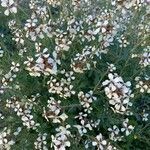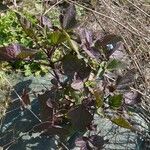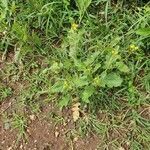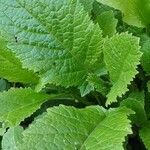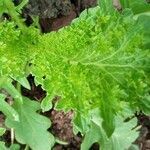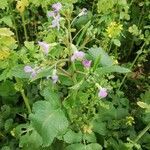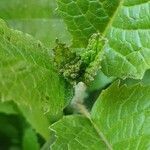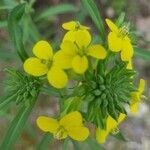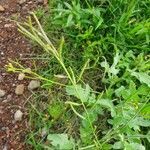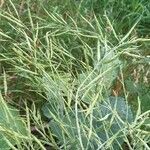Annuals; (± glaucous), ± glabrous. Stems branched distally, 2-10 dm. Basal leaves (early deciduous); petiole (1-)2-8(-15) cm; blade pinnatifid to pinnately lobed, (4-)6-30(-80) cm × 15-150(-280) mm, lobes 1-3 each side. Cauline leaves usually shortly petiolate, rarely sessile; blade (oblong or lanceolate, reduced in size distally), base tapered or cuneate, not auriculate or amplexicaul, (margins dentate to lobed). Racemes not paniculately branched. Fruiting pedicels spreading to divaricately ascending, (slender), (5-)10-15(-20) mm. Flowers: sepals (3.5-)4-6(-7) × 1-1.7 mm; petals pale yellow, ovate to obovate, (7-)9-13 × 5-7.5 mm, claw 3-6 mm, apex rounded or emarginate; filaments 4-7 mm; anthers 1.5-2 mm. Fruits (sessile); spreading to divaricately ascending to nearly erect (not appressed to rachis), torulose, subcylindrical or somewhat flattened, (2-)3-5(-6) cm × 2-5 mm; valvular segment with 6-15(-20) seeds per locule, (1.5-)2-4.5 cm, terminal segment seedless (conic), (4-)5-10(-15) mm, (tapering to slender style). Seeds brown or yellow, 1.2-2 mm diam.; seed coat finely reticulate-alveolate, not mucilaginous when wetted. 2n = 36.
Annual herb, glabrous or somewhat hispid at bases of stem and petioles, somewhat glaucous. Stem erect, usually 30-150 cm high, with long ascending branches in upper part. Basal and lower leaves petioled, not auriculate, with obovate attenuate blade up to 20 by 10 cm, rather coarsely and irregularly dentate, and 1-3 pairs of small lateral lobes; median and upper leaves ± distinctly petioled, not auriculate, obovate and obtuse or oblanceolate and acute, usually 5-10 cm long, irregularly dentate. Racemes corymbiform, rather loose, with numerous flowers; in fruit lax, up to 50 cm long; pedicels ascending, 5-12 mm long. Sepals green, oblong, 4-6 mm long. Petals bright yellow, clawed, with obovate blade, 6-10 mm long. Anthers 1.5-2.5 mm long. Ovary with 10-20 ovules. Siliquae linear, often somewhat torulose, sometimes inflated, 25-75 by 2-3.5 mm, attenuate into a narrowly conical seedless beak, 6-12 mm long; valves with distinct ± keeled midnerve. Seeds dark brown, globose, 1-1.5 mm in diameter, with a distinct fine reticulum.
Annual herbs up to 1 m high with slender ascending branches. Stem hispid near the base, glabrous above. Lower leaves lyratepinnatisect with 1 or 2 pairs of small, broad, lateral lobes and a large, ovate or obovate, terminal lobe; lobes irregularly dentate or lacerate-dentate, sparsely hispid on the lower surface of the veins. Upper leaves glabrous, smaller, simple, entire or dentate, shortly petiolate. Racemes terminal, dense in flower, lax in fruit. Flowers yellow, the petals 7-9 mm long, ±3 mm broad, obovate, shortly clawed. Fruiting pedicels slender, 0.8-1.2 cm, erect to spreading. Siliquae 2.5-5 cm long, 2-3 mm in diameter, linear, tapering; valves convex, irregularly bulged by the ripe seeds, 1-or sub-3-nerved, the lateral nerves ± anastomosing; beak (4-)5-10 mm long, subulateconical. Seeds 16-24, in one row, globose, 1.2-1.5 mm in diameter, brown, the seedcoat reticulately pitted.
Annual herb with lax rosette. Stems erect, glabrous, to 1-(2) m tall. Lvs glaucous, glabrous or sparsely hairy, all petiolate. Lower lvs lyrate-pinnatifid to lyrate-pinnate, with large terminal and 1-2 pairs of lateral lobes, 8-15-(20) × 5-8 cm; margins dentate. Upper lvs simple, becoming linear, toothed to entire, 20-50 × 3-10 mm. Racemes to 45 cm long; open fls about level with buds, or lower. Sepals erecto-patent, narrow-oblong, 4-6 × c. 1 mm. Petals yellow, 6-8 × 2-3 mm. Lateral stamens spreading. Silique terete, glabrous, linear, constricted between seeds, 15-25-(40) × 1.5-2.5 mm; gynophore 0; valves with prominent median and weaker lateral veins; beak tapering, seedless, 5-10 mm long. Seeds yellow to brown, 1-2 mm diam.
Annual herb, up to 1 m high, branches slender, ascending. Stems hispid near base, glabrous above. Leaves: lower leaves lyrate-pinnatisect, lateral lobes in 1 or 2 pairs, small, broad, terminal lobes large, ovate or obovate; upper leaves smaller, simple, shortly petiolate, glabrous, margins entire or dentate. Inflorescence a raceme, dense in flower, lax in fruit. Flowers yellow. Petals obovate, shortly clawed. Fruit a linear siliqua, tapering, valves convex, irregularly bulged by ripe seeds. Seeds 16-24 in one row, globose, brown, seed coat reticulately pitted.
Annual herb, up to 1 m high. Stems erect. Leaves petiolate; lower ones lyrate-pinnatisect with 1 or 2 pairs of small, broad, lateral lobes, terminal large, ovate or obovate, margins dentate, sparsely hispid; upper leaves not clasping stem, petiolate, simple, margins entire or dentate, glabrous. Flowers: in dense racemes; petals 7-9 mm long, yellow; Dec.-Feb. Fruit with pedicels erect to spreading; stipe < 1 mm long or 0, siliquae 25-50 x 2-3 mm, lateral veins ± anastomosing, beak 5-10 mm long, subulate-conical.
It is an erect leafy annual cabbage plant. It grows to about 1 m high. The plant can vary a lot. The leaves are elliptical and deeply divided. They are dark green. The end segment of the leaves is oval. The leaves taper towards the stem and have a strong mustard flavour. The flowers are pale yellow. They have 4 petals. It produces a flower and seed pods at the top. The seed pod is long and narrow. It is 3-5 cm long. The seeds are reddish-brown.
Glabrous, often glaucous annual 3–10 dm; lower lvs to 2 dm, pinnatifid and dentate, the upper progressively reduced, short-petioled or sessile; fls 12–15 mm wide; mature pedicels ascending, 10–15 mm; frs ascending, subterete, 1.5–4 cm; seeds 2 mm, conspicuously and evenly reticulate; 2n=36. Native of Asia, established as a weed throughout our range and w. to the Pacific. June–Oct.
Annual herb, up to 1 m high with slender, ascending branches. Lower leaves lyrate-pinnatisect, sparsely hispid; upper leaves glabrous, simple, shortly petiolate. Beak up to 10 mm long, its tip narrower than stigma. Flowers yellow.
Very similar to B. integrifolia but basal and lower leaves more coarsely and irregularly dentate with 1–3 pairs of small lateral lobes.. Siliquae often longer (up to 75 mm.) with a narrowly conical beak 6–12 mm. long.. Fig. 1.
Silique 2.5–5 cm. long (usually about 3 cm. in our material), narrowly cylindric, valves with reticulate nervation, with a tapering, seedless beak 5–10 mm. long, at its tip narrower than the stigma.
Flowers pale yellow with pedicels up to 8 mm. long in terminal racemes.
Leaves stalked, lyrate-pinnatifid to nearly entire, somewhat glaucous.
Seeds 1–1.3 mm. in diam., subspherical, yellowish-or reddish-brown.
Annual herb 60–70 cm. tall with purplish nearly glabrous stems.
Sepals somewhat spreading.
Petals 4, 5–9 mm. long.
Stamens 6.
